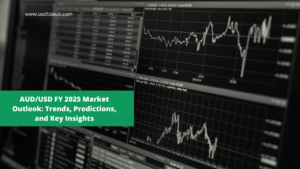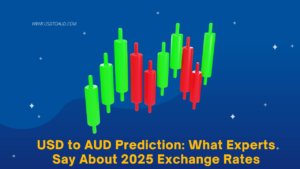The AUD to USD exchange rate is a critical economic metric that affects international trade, travel, investment, and financial decisions between Australia and the United States.
Forecasting this exchange rate involves analyzing economic indicators, financial market trends, and global economic conditions.
For individuals, businesses, and investors, understanding the forecast for AUD to USD can help with strategic planning.
AUD to USD Exchange Rate
The AUD to USD exchange rate indicates how much 1 Australian Dollar (AUD) is worth in United States Dollars (USD).
For example, if the exchange rate is 1 AUD = 0.65 USD, it means 1 Australian Dollar can be exchanged for 65 US cents. This rate fluctuates continuously based on economic and financial market factors.
Factors Influencing the AUD to USD Exchange Rate
Several factors influence the AUD to USD exchange rate:
1. Interest Rates
The interest rates set by the Reserve Bank of Australia (RBA) and the Federal Reserve (Fed) significantly affect currency values:
- Higher interest rates attract investors seeking higher returns.
- If Australia raises rates while the US keeps rates unchanged, the AUD tends to appreciate.
2. Commodity Prices
Australia is a major exporter of iron ore, coal, natural gas, and agricultural products.
- Rising commodity prices boost Australia’s trade surplus, strengthening the AUD.
- A drop in commodity prices can weaken the AUD.
3. Economic Data
Key economic indicators like GDP growth, employment rates, and inflation impact exchange rates.
- Strong economic performance in Australia supports the AUD.
- Weak performance or uncertainty can drive the AUD lower.
4. US Dollar Strength
The US Dollar is considered a safe-haven currency during global uncertainty:
- If investors seek safety, they move funds to the USD, causing the AUD to weaken.
- Conversely, a risk-on sentiment benefits the AUD as investors look for higher yields.
5. Trade Balance
Australia’s trade balance plays a significant role:
- A trade surplus (exports > imports) increases AUD demand.
- A trade deficit can reduce demand, weakening the AUD.
6. Global Market Sentiment
The AUD is often referred to as a “risk currency” due to its sensitivity to global market sentiment:
- Positive market sentiment strengthens the AUD.
- Negative sentiment weakens it as investors favor the USD.
Historical Trends of AUD to USD Exchange Rate
Understanding past trends helps contextualize forecasts for the AUD to USD exchange rate.
| Year | Average AUD to USD Exchange Rate | Key Factors |
|---|---|---|
| 2001 | 1 AUD = 0.50 USD | Global slowdown, strong USD |
| 2008 | 1 AUD = 0.96 USD | Pre-Global Financial Crisis (GFC) boom |
| 2011 | 1 AUD = 1.03 USD | Peak commodity prices; AUD above parity |
| 2015 | 1 AUD = 0.75 USD | Declining commodity prices |
| 2020 | 1 AUD = 0.68 USD | COVID-19 economic disruptions |
| 2023 | 1 AUD = 0.67 USD | US interest rate hikes, strong USD |
Highlights of Historical Performance
- The AUD reached parity with the USD in 2011, driven by a commodity boom and strong Australian growth.
- After the Global Financial Crisis and commodity price drops, the AUD weakened significantly.
- Post-pandemic, global inflation and the Fed’s interest rate hikes caused further AUD depreciation.
Current AUD to USD Exchange Rate
As of mid-2024, the AUD to USD exchange rate fluctuates around 0.65 – 0.68 USD per 1 AUD. However, this can change rapidly due to economic reports, central bank decisions, and geopolitical events.
| Date | AUD to USD Exchange Rate |
|---|---|
| January 1, 2024 | 0.67 USD |
| February 1, 2024 | 0.66 USD |
| March 1, 2024 | 0.68 USD |
| April 1, 2024 | 0.65 USD |
| May 1, 2024 | 0.66 USD |
These rates demonstrate slight volatility influenced by economic events.
Forecast for AUD to USD in 2024
Forecasting exchange rates involves analyzing economic trends, interest rates, and global conditions. Here are some expert predictions for the AUD to USD exchange rate in 2024:
Major Bank and Analyst Forecasts
| Quarter | Forecast AUD to USD Rate | Analyst Notes |
|---|---|---|
| Q1 2024 | 0.66 USD | US interest rates remain elevated |
| Q2 2024 | 0.67 USD | Slight improvement in AUD sentiment |
| Q3 2024 | 0.69 USD | RBA interest rate hikes expected |
| Q4 2024 | 0.70 USD | Commodity prices stabilize |
Key Drivers of the Forecast
- Interest Rate Differentials:
If the RBA increases rates while the Fed holds steady, the AUD will strengthen. - Commodity Demand:
Sustained demand for Australian exports will support the AUD. - Global Economic Recovery:
A recovery in China and improved global trade conditions will benefit the AUD.
What Analysts Are Saying
1. Commonwealth Bank of Australia (CBA)
CBA predicts the AUD to reach 0.70 USD by the end of 2024, driven by stronger commodity prices and a stabilizing global economy.
2. Westpac Bank
Westpac forecasts a range of 0.67 to 0.69 USD for most of 2024, citing the RBA’s cautious approach to rate hikes and global risk sentiment.
3. ANZ Bank
ANZ projects an optimistic scenario where the AUD hits 0.70 USD if economic conditions in Australia improve alongside stronger export demand.
Impact of AUD to USD Forecast on Key Sectors
1. Trade and Exports
A stronger AUD makes Australian exports more expensive for foreign buyers, potentially reducing demand for commodities like iron ore, coal, and agricultural products. Conversely, a weaker AUD makes exports more competitive.
2. Tourism
- For Australian travelers heading to the US, a weaker AUD means higher travel costs.
- For US travelers, a stronger AUD may deter visits to Australia.
3. Investments
- Australian businesses relying on US imports face higher costs when the AUD weakens.
- International investors watch the AUD to determine investment attractiveness.
4. Real Estate
- Foreign buyers find Australian property more attractive when the AUD is weak.
- Australian investors looking to purchase property in the US benefit from a stronger AUD.

How to Use the Forecast for Financial Planning
1. Hedging Strategies
Businesses and individuals can hedge against exchange rate risks using forward contracts and options to lock in favorable rates.
2. Investment Planning
Investors can time their international investments based on forecast trends. For example:
- A stronger AUD is ideal for buying US assets.
- A weaker AUD benefits US investors in Australian markets.
3. Travel Budgeting
Travelers can plan trips when the AUD is expected to strengthen, reducing costs abroad.
Short-Term vs Long-Term Forecast
| Time HorizonForecast Rate (AUD to USD)FactorsShort-Term0.65 – 0.68 USDGlobal inflation, Fed policiesMedium-Term0.68 – 0.70 USDRBA policy shifts, commodity recoveryLong-Term0.70+ USDEconomic growth and global stability |
|---|
Conclusion
In summary, the forecast for the AUD to USD exchange rate in 2024 reflects cautious optimism.
While challenges like global uncertainties and US economic strength persist, rising commodity prices and potential RBA rate hikes could support a stronger AUD.
Businesses, investors, and individuals should monitor economic developments to make informed decisions.
FAQs
1. What is the current AUD to USD exchange rate?
The current AUD to USD rate fluctuates around 0.65 to 0.68 USD, depending on market conditions.
2. Will the AUD get stronger in 2024?
Analysts forecast a gradual strengthening of the AUD to around 0.68 – 0.70 USD by the end of 2024 if economic conditions improve.
3. What drives the AUD to USD exchange rate?
Key factors include interest rates, commodity prices, trade balance, and global market sentiment.
4. Where can I check real-time exchange rates?
You can check rates on platforms like XE.com, Yahoo Finance, or your bank’s exchange rate portal.
5. How does a weak AUD affect Australians?
A weak AUD makes imports, international travel, and education more expensive but boosts export competitiveness.

















